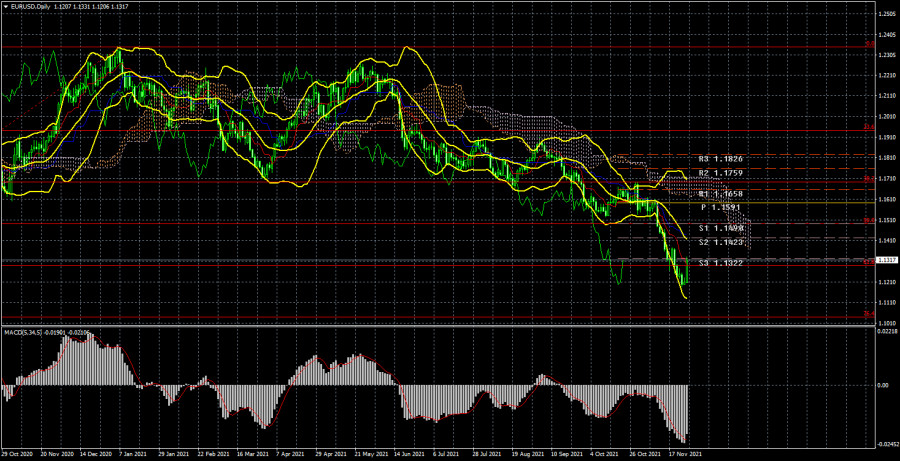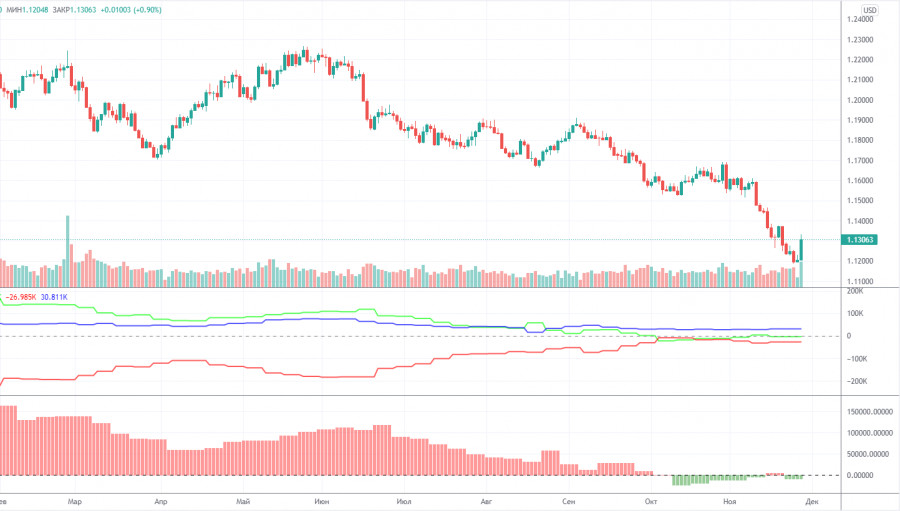
EUR/USD 24-hour TF analysis.

The EUR/USD currency pair has fallen by another 80 points during the current week. However, we say "it has fallen yet" since in general the downward movement of the last weeks and even months has continued. On Friday, the quotes of the euro currency rose by 110 points, thus, formally, the euro closed the week in the black. Nevertheless, hardly anyone has any doubts now that our trend is downward. And it is unlikely that just one day will be enough for the pair to break it. We continue to believe that the US dollar is growing in some way unfairly, but at the same time not unreasonably. In other words, there have been grounds for strengthening the dollar in recent weeks. Do not go far and dig deep: the Fed's monetary policy is tightening and looks like it will tighten in the next six months; the ECB's monetary policy does not seem to tighten, and if it does, then formally, for show. Otherwise, there is no way to explain the ECB's desire to curtail the PEPP program on time, at the end of March 2022, and immediately expand the APP program. Thus, such an imbalance between the monetary policies of the two central banks is a good reason for the growth of the dollar and the fall of the euro. Of course, we can also recall that the fourth "wave" of the pandemic is raging in the European Union. And if a couple of months ago the number of diseases was simply growing, now Austria has gone into another "lockdown", Germany updates the anti-records for the number of new diseases every day, the Netherlands is not far away from it. And we are talking about those countries where there are no special problems with vaccines. Hardly anyone doubts that Germany was one of the first to receive vaccines and in sufficient quantity. But people in Germany are not in too much of a hurry to get vaccinated, which, according to the government, is the reason for the high rate of spread of the virus. However, it turns out a strange situation: the virus spread more slowly when there were no vaccines at all. Due to the difficult situation with the "crown" in the European Union, the euro currency could also decline in recent weeks.
Analysis of the COT report.

During the last reporting week (November 15-19), the mood of non–commercial traders has changed quite a lot. A group of "Non-commercial" traders opened 7 thousand contracts for purchase and 20.5 thousand contracts for sale during the week. Thus, the net position for professional traders decreased by 13.5 thousand, and the mood became more "bearish". It should be noted that the European currency has fallen quite seriously in the last few weeks. But the net position for the "Non-commercial" group, starting from October, practically does not change. This is indicated by the green line of the first indicator in the illustration above. Almost all this time it has been near the zero level, indicating the absence of serious changes in the mood of major players. Thus, if the general trend remains the same - over the past 10 months, major players have seriously reduced the number of longs and increased the number of shorts, then nothing like this has been observed in the last few weeks, and the European currency has been falling anyway. This suggests that what is happening on the market now does not quite correspond to the actions of major players. The second indicator (a net position for professional traders in the form of a histogram) shows at all that in the last 6 weeks the mood of traders has become less "bearish." In theory, at this time, the euro currency should have been growing, not falling. Thus, if we conclude only from COT reports, then the further fall of the euro currency is completely unobvious. The new COT report was not released on Friday, most likely due to Thanksgiving in the United States.
Analysis of fundamental events.
The current week has been as boring as possible in terms of macroeconomic and fundamental events. In the European Union, Christine Lagarde again made speeches almost every day and, of course, she did not tell the markets anything new and interesting. Simply because the head of the ECB cannot please traders with new, important information every day. But Lagarde assured the markets even more strongly that the ECB is not going to raise rates in 2023 and will just wait until inflation starts to decline by itself. In the States, the second estimate of GDP for the third quarter was published, as well as a relatively important report on orders for long-term goods. Both reports turned out to be worse than forecasts, but the dollar continued to grow. And only on Friday, when the calendars of the European Union and the United States were empty, the pair show good growth, with a probability of 99% is a banal correction provoked by profit-taking on short positions.
Trading plan for the week of November 29 - December 3:
1) On the 24-hour timeframe, the trend remains downward. At the moment, the quotes remain below the Kijun-sen line, and the markets continue to show that they are not ready to buy the euro currency. Thus, the downward movement may resume with a target of 1.1038. The fundamental background supports the further fall of the euro and the growth of the dollar at this time, but we also believe that all factors have long been worked out by the market, so we allow the downward trend to end.
2) As for purchases of the euro/dollar pair, in the current conditions, they should be considered no earlier than fixing the price above the critical line. And ideally - above the Ichimoku cloud, because the price has already overcome the Kijun-sen several times, but then could not continue moving up. There are a few prerequisites for a new uptrend to begin in the near future. First of all, technical.
Explanations to the illustrations:
Price levels of support and resistance (resistance /support), Fibonacci levels - target levels when opening purchases or sales. Take Profit levels can be placed near them.
Ichimoku indicators(standard settings), Bollinger Bands(standard settings), MACD(5, 34, 5).
Indicator 1 on the COT charts - the net position size of each category of traders.
Indicator 2 on the COT charts - the net position size for the "Non-commercial" group.